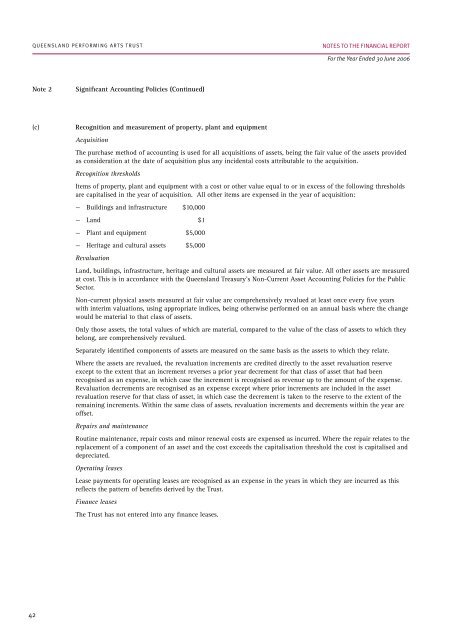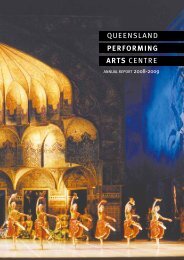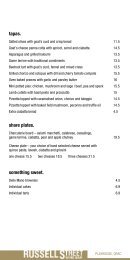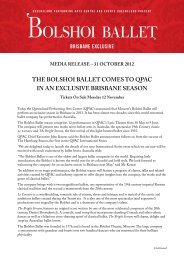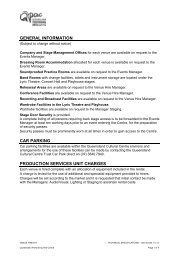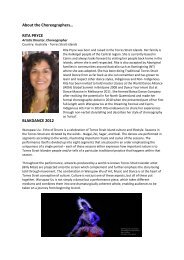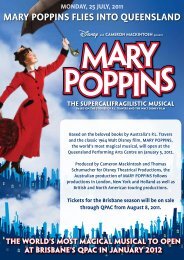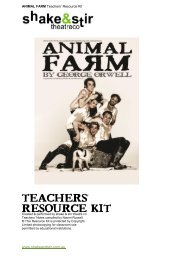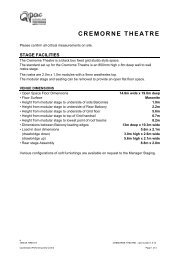Chairman's - QPAC
Chairman's - QPAC
Chairman's - QPAC
Create successful ePaper yourself
Turn your PDF publications into a flip-book with our unique Google optimized e-Paper software.
QUE E NSL A N D PE RFO RM I NG ARTS TRUST<br />
NOTES TO THE FINANCIAL REPORT<br />
QUE E NSL A N D PE RFO RM I NG ARTS TRUST<br />
NOTES TO THE FINANCIAL REPORT<br />
For the Year Ended 30 June 2006<br />
For the Year Ended 30 June 2006<br />
Note 2<br />
Significant Accounting Policies (Continued)<br />
Note 2<br />
Significant Accounting Policies (Continued)<br />
(c)<br />
Recognition and measurement of property, plant and equipment<br />
Acquisition<br />
The purchase method of accounting is used for all acquisitions of assets, being the fair value of the assets provided<br />
as consideration at the date of acquisition plus any incidental costs attributable to the acquisition.<br />
Recognition thresholds<br />
Items of property, plant and equipment with a cost or other value equal to or in excess of the following thresholds<br />
are capitalised in the year of acquisition. All other items are expensed in the year of acquisition:<br />
— Buildings and infrastructure $10,000<br />
— Land $1<br />
— Plant and equipment $5,000<br />
— Heritage and cultural assets $5,000<br />
Revaluation<br />
Land, buildings, infrastructure, heritage and cultural assets are measured at fair value. All other assets are measured<br />
at cost. This is in accordance with the Queensland Treasury’s Non-Current Asset Accounting Policies for the Public<br />
Sector.<br />
Non-current physical assets measured at fair value are comprehensively revalued at least once every five years<br />
with interim valuations, using appropriate indices, being otherwise performed on an annual basis where the change<br />
would be material to that class of assets.<br />
Only those assets, the total values of which are material, compared to the value of the class of assets to which they<br />
belong, are comprehensively revalued.<br />
Separately identified components of assets are measured on the same basis as the assets to which they relate.<br />
Where the assets are revalued, the revaluation increments are credited directly to the asset revaluation reserve<br />
except to the extent that an increment reverses a prior year decrement for that class of asset that had been<br />
recognised as an expense, in which case the increment is recognised as revenue up to the amount of the expense.<br />
Revaluation decrements are recognised as an expense except where prior increments are included in the asset<br />
revaluation reserve for that class of asset, in which case the decrement is taken to the reserve to the extent of the<br />
remaining increments. Within the same class of assets, revaluation increments and decrements within the year are<br />
offset.<br />
Repairs and maintenance<br />
Routine maintenance, repair costs and minor renewal costs are expensed as incurred. Where the repair relates to the<br />
replacement of a component of an asset and the cost exceeds the capitalisation threshold the cost is capitalised and<br />
depreciated.<br />
Operating leases<br />
Lease payments for operating leases are recognised as an expense in the years in which they are incurred as this<br />
reflects the pattern of benefits derived by the Trust.<br />
Finance leases<br />
The Trust has not entered into any finance leases.<br />
(d)<br />
Depreciation and amortisation of property, plant and equipment<br />
Land is not depreciated as it has an unlimited useful life.<br />
Depreciation on buildings, infrastructure and equipment and motor vehicles, is calculated on a straight-line basis<br />
so as to write-off the net cost or revalued amount of each depreciable asset, less its estimated residual value,<br />
progressively over its estimated useful life to the Trust.<br />
Capital work-in-progress is not depreciated until it reaches service delivery capacity.<br />
Where assets have separately identifiable components, these components are assigned useful lives distinct from the<br />
asset to which they relate. Any expenditure that increases the originally assessed capacity or service potential of an<br />
asset is capitalised and the new depreciable amount is depreciated over the remaining useful life.<br />
The depreciable amount of improvements to or on leasehold land is allocated progressively over the estimated<br />
useful lives of the improvements to the Trust or the unexpired period of the lease, whichever is shorter.<br />
Major depreciation rates used are listed below and are consistent with the prior year unless otherwise stated:<br />
Buildings and leasehold improvements 4 to 20%<br />
Motor vehicles 20%<br />
Plant and equipment 1 to 33%<br />
Concert Hall Grand Organ 2%<br />
Intangibles<br />
All intangible assets with a cost or other value greater than $100,000 are recognised in the financial statements,<br />
with items of a lesser value being expensed. Each intangible asset is amortised on a straight line basis over its<br />
estimated useful life to the agency, less any anticipated residual value. Current amortisation rates are either 20% or<br />
33.3%<br />
Impairment of non-current assets<br />
All non-current physical and intangible assets are assessed for indicators of impairment on an annual basis. If an<br />
indicator of possible impairment exists the assets recoverable amount is determined. The recoverable amount is<br />
determined as the higher of the assets fair value (net of selling costs) and the depreciated replacement cost.<br />
An impairment loss is immediately recognised in the income statement. If the asset in question is carried at a<br />
revalued amount then any impairment loss is first offset against the asset revaluation reserve of the relevant asset<br />
class to the extent available.<br />
If an impairment loss subsequently reverses, the carrying amount of the asset is increased to the revised estimate<br />
of its recoverable amount, but only to the extent that the carrying amount does not exceed the carrying amount<br />
that would have been determined had no previous impairment loss been recognised for the asset. A reversal of an<br />
impairment loss is recognised as income, unless the asset is carried at a revalued amount, in which case the reversal<br />
of the impairment loss in treated as a revaluation increase.<br />
Cash assets<br />
For the purposes of the Balance Sheet and the Cash Flow Statement, cash assets include all cash and cheques<br />
receipted but not banked at 30 June 2006 as well as deposits at call with financial institutions. It also includes<br />
liquid investments with short periods to maturity that are convertible readily to cash on hand, at the investor’s<br />
option and that are subject to a low risk of changes in value.<br />
(e)<br />
(f)<br />
(g)<br />
42<br />
43


